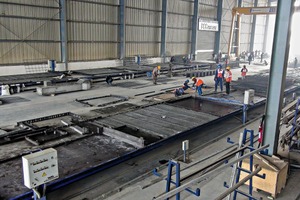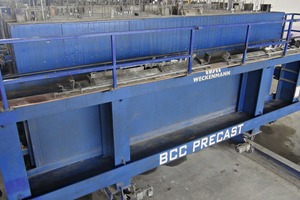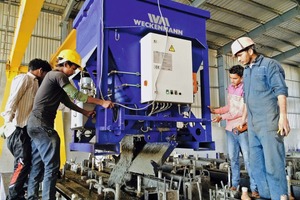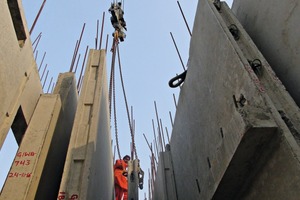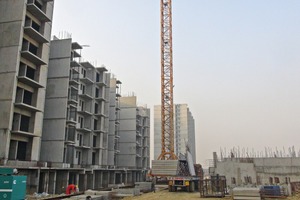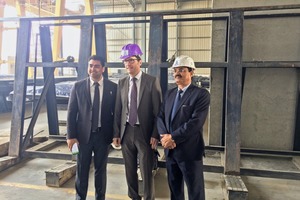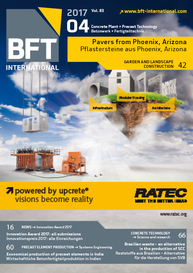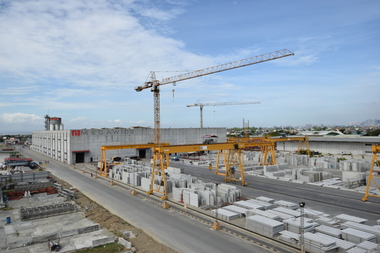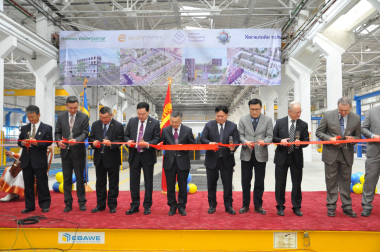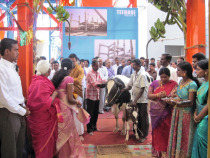Economical production of precast elements for affordable living space in India
BCC Infrastructures Pvt Ltd (BCC) is one of the major real property developers in India and is currently building around 9,000 dwelling units in Ghaziabad. To reduce construction time and costs, BCC builds with precast elements manufactured at a Weckenmann stationary production plant.
The demand for affordable living space is high, not only in European metropolises that include London, Paris, Berlin, and Munich, but also and especially so in populous and emerging countries such as India. With a population density of more than 380 inhabitants/km² and a total population of more than 1.2 billion, India is the most highly populated country on earth after China. Experts assume that, by the year 2025, more people will live in India than in China.
Added to the significant annual population growth of 15 million annually (1.4 % p.a.) is increasing urbanization owing to migration of people from rural regions. More than 46 cities in India have a population of more than 1 million, among them such mega-cities as Mumbai with 18 million and Delhi with nearly 17 million. The creation of a modern infrastructure and, most of all, affordable living space poses a great challenge to Indian politics and is also a key requisite for continued positive development of the Indian economy. India is among the top ten economies in the world and cannot afford stagnation of economic development. “Smart Cities” and “Housing for All” are two programs for meeting the enormous demand for housing in India.
Creation of affordable living space
BCC Infrastructures Pvt Ltd (BCC), founded in 1989 in Ghaziabad near Delhi by S. P. Sing, demonstrates how affordable, high-quality dwelling units can be created within a short time. In the past 35 years, more than 50 large-scale real estate projects were implemented in India under the direction of BCC, which currently employs 450 women and men. Kumar Bharat, the son of the company founder, takes particular pride in the Bharat City mega-project, currently underway northeast of Delhi, not quite 20 km west of Ghaziabad, where BCC is developing and building a total of 9,000 dwelling units in apartment blocks with 15 stories each.
The management of Kumar Bharat had realized early on, already during implementation of the first phase of the Bharat City project, that the completion of this mega-project by classic construction methods (in-situ concrete floors and brick walls) would take far too long and would break the budget. “We clearly recognized that we would not be able to meet the demands of cost efficiency and quality in this manner,” says Bharat, “and we wanted to cut the construction time in half. So we intensively explored alternative means and then decided to build Bharat City II with precast elements.”
Made-to-measure precast plant
After much research, talks, and a visit to Dormettingen in the German state of Baden-Württemberg, the choice fell on the company Weckenmann Anlagentechnik GmbH & Co. KG as partner for erecting the precast plant. “We got high marks, for one, because of our nearly 60-year experience as plant engineering firm. But, most of all, it was our concept for a made-to-measure precast element production that convinced BCC,” says Benjamin Zeh, Area Sales Director at Weckenmann, who added: “We conceived and built for BBC a stationary production plant for precast floor plates and massive interior and exterior walls.”
The plant comprises two battery forms with 20 compartments each for the massive precast walls and two gigantic form tables of 40 m length each for production of the floor plates. The formwork system from Weckenmann, fitted with integrated magnets, ensures fast and precise placement of the formwork for the precast elements. A crane-operated placing boom ensures uniform distribution of the concrete.
Both slide-opening and vibration processes are fully automatic, resulting in a highly homogeneous surface. Following a four-week test phase in May of 2015, the 250 workers at BCC in the Weckenmann plant now manufacture around 500 m² of precast floor plates per day and 1,000 m² of solid walls.
“The surface quality and the dimensional accuracy of our precast elements are truly outstanding,” says Bharat with pride. “But that is not all: we can manufacture in any kind of weather. The electrical lines, switches, and pipes are embedded and, what’s more, we require fewer workers for faster erection. Compared to construction methods customary in India, we will save two years of construction time for every residential tower built in Bahrat City II.
In 105 days 9,200 m² of residential floor space in 15 stories
Anyone who knows about the shortage of skilled workers in India and about the fact that many workers leave a construction site during the harvest season will realize that a large-scale project with a construction area of just short of 700,000 m² can be cost-efficiently implemented in a reliable timeframe only by means of precast construction. One hundred workers can in only 105 days erect a solid residential tower of more than 3,000 precast elements (precast floor plates, loadbearing and non-loadbearing walls, stairs, and balconies). Such a tower meets all requirements of its future occupants, as well as the stringent Indian seismic safety standards. Bharat City, the same as Delhi, is located in a highly earthquake-prone zone. Accordingly, the building requirements that BCC must meet are strict. Technical experiments carried out in India show that the precast concrete walls from the Weckenmann plant are capable of resisting greater forces than walls constructed by conventional methods.
Building with precast elements has a future
BCC is confident that more precast industrial facilities such as the one in Bharat City will be taken into operation in India in the near future. BCC Director Kumar Bharat: “In order to quickly raise the infrastructure in our country to a higher level, we will need four to five more precast facilities of the Weckenmann type – and this in every 29 of our states.”
For Hermann Weckenmann there is also no alternative to building with precast elements. “High-quality living space for millions of people cannot be erected faster and more cost-efficiently. Concrete has a long useful life, is stable, is resistant to weather and termites – and can, moreover, be processed nearly everywhere.”
The fact that the renowned magazine National Geographic on its television channel reported on the project shows the high public and media interest in the pioneering Bharat City II project. In the television report, Hermann Weckenmann had the opportunity to elaborate in detail on the advantages of building with precast elements.
Weckenmann with a subsidiary in India
By establishing an Indian subsidiary in the metropolis of Bangalore in southern India, the worldwide active medium-sized Swabian company reacted pro-actively to the positive prospects involved. The head of Weckenmann Engineering (India) Pvt. Ltd. is Ans Hariharasudhan, who himself worked for a long time in a precast plant in southern India. He knows the special technical requirements and, being Indian, is familiar with all cultural traditions. He remains calm, for example, when activities at an Indian construction site come to a temporary standstill owing to unexpected cultural events.

